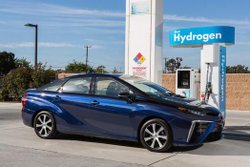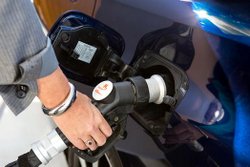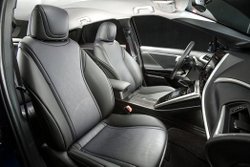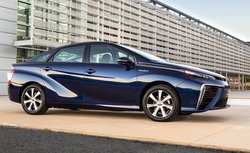Laboratory On Wheels
If you live in California, you have the opportunity to participate in a real world experiment: Leasing a 2017 Toyota Mirai. How can leasing a car be considered an experiment? When the car is a hydrogen fuel cell electric car, that is how. Heck, the word Mirai in Japanese means “the future,†which this car certainly could be.
The idea of propelling a car with hydrogen puts Toyota on the leading edge of this technology, just like in 2000 when they launched the Prius Hybrid in the United States. It was a bold step then, taking a massive financial commitment, to think consumers would take to driving a car powered by anything other than an internal combustion engine (ICE). Fast forward to 2017, and if a car manufacturer doesn’t have an electrified car in their line-up, they will need to do so real, real soon. Note: Honda, Hyundai, Mercedes-Benz and others also sell hydrogen fuel cell vehicles, but for this story we are concentrating on the Toyota Mirai.
How Hydrogen Fits into the Electrification of Cars
Electrification of vehicles comes in three variations: a pure battery electric (EV, electric motor only), plug-in hybrid (PHEV, capable of recharging the battery and extended all-electric range, but retaining an engine) and hybrid (internal combustion engine and electric motor with limited all-electric range). These vehicles are common on the road (depending where you live), and built by several manufacturers.

The concept on these is pretty straight forward, without getting into the minutia of the technology. Electricity is stored in batteries (a variation of lithium-ion or nickel-metal hydride chemestries) by plugging into a common wall socket (120V), a Level 2 charger (240V) or a fast-charger (480V), or through an on-board generator or regenerative braking. The charged batteries can drive the vehicle’s electric motor and propel the car or, in the hybrid case, potentially aid the ICE to move it along.
The fastest plug-in charge times with the 480V charger are about twenty minutes, from a low battery to 80-percent fully charged, depending on the size of the battery. For lower voltage charging the time can be from eight to 20 hours. So, the challenge is finding a fast charger, which can be an adventure, leading to drivers wondering (fearing) running out of juice and no way to recharge. Note: Tesla has its proprietary charging stations, strategically located on a few major highways and cities in several states, but not all. So it is possible to drive a Model S, X or 3 just like you would a gasoline-powered car, though with more frequent stops for refueling.
Hydrogen fuel cells do it a bit differently. Hydrogen is used to create electricity on board to propel the electric motors that propel the car. Fuel cell electric vehicles (FCEV) are refueled in a very similar manner to an ICE vehicle. You find a hydrogen station, swipe your card, insert the nozzle, turn on the pump and in about five minutes–or the same time as refueling with gasoline–and you are good to go. Sounds simple, right?
The hydrogen producers and hydrogen fuel cell vehicle manufacturers are in a chicken and egg situation. The fuel companies are reluctant to build hydrogen fueling stations until there are enough FCEV on the road to make it financially worthwhile, and the car manufacturers are waiting for a comprehensive network of fueling stations to be built before investing in FCEV mass production. Not sure who will blink first, but Toyota, Honda, Hyundai and Mercedes-Benz have all made a commitment to FCEV technology, so the hope is that the two sides will come together real soon on a solution.

The Difference Between EV and Fuel Cell Electric Vehicles
The 2017 Toyota Mirai has a 1.7-kWh nickel-metal hydride battery that is charged with electricity created from the hydrogen stored in the two carbon-fiber tanks. The pressurized hydrogen gas combines with oxygen in the fuel cell to produce electricity. In this process heat and water are produced and the chemical reaction becomes electricity. The only byproduct of this process is water, which is clean enough to drink (though it’s not recommended), and can be seen dripping from the tailpipe of the car.
Laboratory On Wheels: Fueling
You will be eager to learn how to fuel the Mirai. Start by going to The California Fuel Cell Partnership website to find stations that are on your driving route. Unlike the thousands of gasoline stations in California, there are only fifty hydrogen stations statewide. Most are open 24/7 and usually unattended. Unfortunately, they also are not always operational. One of my trips was from

South Orange County to Santa Monica, a mere seventy-two freeway miles but one that necessitated topping-off the hydrogen tank. On the day I was making this trip I found five stations on my route, but three of them were out of service. This apparently is not an uncommon occurrence with this nascent industry from online reports.
Once at the station, the fueling process is explained through a video that plays on the pump as well as on a sign with step-by-step instructions. Quick lesson: The nozzle notches into the filler pipe, followed by the twisting of a handle to lock the nozzle in place. It can be a bit tricky, but be patient, it will eventually fit. If there are two pressure options on your pump, you always want to select 70 Bar, which is 10,000 psi, to get a better fill. The filling will start and stop for a few seconds at a time, but a complete fill is under five minutes. When removing the nozzle you will notice it is cold. This is because the hydrogen gas is cooled to right around zero degrees Fahrenheit to increase the hydrogen’s density, which results in more gas filling the tank. That’s it! Take your receipt for your free fill-up (more on that free gas later) and off you go.
Laboratory On Wheels: On the Road
The 2017 Toyota Mirai Clean Fleet Report tested for two weeks had a 113-kW AC synchronous motor producing 151 horsepower and 247 pounds-feet of torque. The Environmental Protection Agency estimates the fuel economy to be 67 mpge for city, highway and combined (the “e” is for equivalent as in gasoline gallon equivalent) . Toyota estimates a 310-mile driving range. In 469 miles of driving throughout Southern California, our Mirai’s dash gauge never showed more than 238 miles of driving range. Toyota said the gauge is conservative in its read-out purposely to save owners from running out of fuel.

The front-wheel drive Mirai gets to 60 mph in a bit more than nine seconds, which is respectable to move 4,075 lbs., but certainly not fast. You can feel the heaviness–in a good way–with a ride so very smooth and comfortable you would swear you were in a much larger and expensive luxury car.
The electric power-assisted rack-and-pinion steering, the front MacPherson struts with stabilizer bar and rear Torsion beam suspension delivers a smooth and stable ride. SoCal concrete freeways are grooved, so tire noise in any car is common. The seams between the concrete sections can, if hit at the right sped, produce a rhythmic thumpity-thumpity-thump. Not fun. However, the Mirai tire and wind noise was damped very well, making for an extremely quiet and pleasant ride. It seems obvious, but it needs to be said, that there is no engine noise because there is no engine. Ah, the beauty of an EV!
The 17-inch alloy wheels and 215/55R17 tires deliver handling that was direct with little body roll. Nothing sporty about the Mirai, but then again Toyota does not market it as a sporty car.
The Mirai’s battery is replenished while driving through the regenerative braking charging system. This technology converts kinetic energy into electric energy when applying the brakes or coasting and stores it in the battery. This process can be viewed on a dash gauge where you can watch the power flow into and out of the battery and electric motor. The regenerative brakes had solid stops with a system consisting of power-assisted ventilated front discs with solid rear discs, anti-lock brakes (ABS), brake assist and electronic brake-force distribution.
Laboratory On Wheels: Interior
The 2017 Toyota Mirai can seat four full-size adults, with the rear passengers getting good head and leg room, and a center armrest with cup holders. The front and rear seats are heated and covered in Softex, a synthetic leather designed for wear and ease of cleaning. The front seats are power adjustable. Comfort-wise, the seats are firm and, for the driver, finding a good driving position is helped by the power tilt and telescopic steering column.

Gauges are located in the center of the dash with none, as in zero, being directly in front of the driver. It took a bit of adjustment to look 10 degrees to the right at all times, but it is odd. The largest element of the dash is an 11-inch high-resolution touch-screen color display housing Toyota’s Entune, JBL Premium Audio system and navigation. The 11-speaker system included an AM/FM cache radio with MP3/WMA playback capability, SiriusXM (which includes 90-day trial subscription) and HD AM Radio with iTunes. Also an auxiliary audio jack, USB port with iPod connectivity and control, hands-free phone, advanced voice recognition, Siri Eyes Free, and music streaming via Bluetooth. The audio system has knobs for volume and channel selection, something Clean Fleet Report requires for a sound system to get an A+ grade from our discerning staff.
Gear selection is by a joystick on the lower center stack. Drive settings of Eco and Power modes, and the parking brake buttons, are an easy reach near the gear selector.
Laboratory On Wheels: Exterior
New for 2016 and carried-over for 2017, the Mirai is not wedge-shaped like the Prius. The front end is dominated by two large air scoops on each corner of the lower fascia, topped by attractive rectangular quad-LED projector headlamps. The sloped hood leads to a raked windshield and roof that peaks at the B pillar, and then gently slopes to where the rear glass meets the short trunk hood. The rear is highlighted by the large LED brake/taillight combo.
Pricing

The 2017 Toyota Mirai comes in one model with no options other than exterior color. The MSRP is $57,500 as a purchase, but most people will be leasing at $349 a month for 36 months. This price excludes the $835 delivery fee.
The Mirai qualifies for Federal tax credits and California state incentives that could reduce your final cost. Clean Fleet Report recommends contacting your CPA before considering a Mirai purchase so you are completely clear on the tax credits. Not relying on the dealer to provide this information will serve them and you best.
Also worth noting is the Mirai qualifies for California’s coveted white car pool stickers, allowing the driver, with no passenger, to use the HOV lane. This is no small thing when trying to get anywhere on a freeway in the Golden State.
Safety and Warranties
The 2017 Mirai has not been rated by the National Highway Traffic Safety Administration or the Insurance Institute for Highway Safety. However, it is well-equipped for safety with eight airbags. Advanced driver pre-collision technology includes lane departure alert, blind spot monitor, dynamic radar cruise control, pedestrian detection and an engine immobilizer. Remote keyless entry,

push button start/stop, power door locks, heated and power outside mirrors, a tire pressure monitoring system, vehicle stability and traction control, brake assist and smart stop technology add to round out the equipment lineup.
The 2017 Mirai comes with these warranties:
- Fuel Cell System  –  Eight years/100,000 miles
- Powertrain  –  Five years/60,000 miles
- Basic  –  Three years/36,000 miles
Observations: 2017 Toyota Mirai Hydrogen Fuel Cell EV
Hydrogen is listed first on the Periodic Table of the Elements. It’s good being first, but there is a reason as hydrogen is the lightest of all elements. It has a near unlimited abundance, but is never found by itself, so to be extracted for use as a fuel is an expensive proposition. It currently sells for around $10 per kilogram, roughly the equivalent to a gallon of gasoline. Currently, to run an FCEV compared to a battery electric will cost about four times as much, based on your cost of electricity.

Toyota is fully aware of the cost of compressed hydrogen gas to power the Mirai and are cognizant that Mirai owners are to be valued for their progressive outlook on life and willingness to test new technology. Toyota rewards their customers with a pre-loaded, $15,000 fuel card. This is the equivalent of three years worth of hydrogen gas at 12,000 miles per year. Conveniently, this is the length of your lease. Therefore, you do not need to be concerned with the price of hydrogen gas.
Hydrogen fuel cell passenger vehicles are in the first phase of acceptance and development, so expect a slow roll-out. We are seeing this technology appear in city buses and potentially in over-the-road semi trucks in the not so far-off future. The development of hydrogen to power electric vehicles is being conducted by private industry and government programs on a worldwide basis, so expect announcements and breakthroughs.
Is the Mirai right for your lifestyle and driving pattern? This, of course, is a personal decision that will take time to determine. Right now where you live (and where the refueling stations are) is a prime determinant. If you live in the right place, your research and comparison shopping, with test drives of many electric and non-electric cars, will be the way to get you to that decision. If you see yourself as a trailblazer who wants to only leave  a trail of water behind your car as you cruise down the road, then the Mirai is your next car.
Whatever you end up buying, enjoy your new car and as always, Happy Driving!
Related Stories You Might Enjoy:
First Drive: 2016 Toyota Mirai
News: Toyota Mirai Hits the Market
First Drive: 2017 Honda Clarity FCEV
News: Honda Clarity Fuel Cell Model Introduced
Disclosure:
Clean Fleet Report is loaned free test vehicles from automakers to evaluate, typically for a week at a time. Our road tests are based on this one-week drive of a new vehicle. Because of this we don’t address issues such as long-term reliability or total cost of ownership. In addition we are often invited to manufacturer events highlighting new vehicles or technology. As part of these events we may be offered free transportation, lodging or meals. We do our best to present our unvarnished evaluations of vehicles and news irrespective of these inducements.
Our focus is on vehicles that offer the best fuel economy in their class, which leads us to emphasize electric cars, plug-in hybrids, hybrids and diesels. We also feature those efficient gas-powered vehicles that are among the top mpg vehicles in their class. In addition, we aim to offer reviews and news on advanced technology and the alternative fuel vehicle market. We welcome any feedback from vehicle owners and are dedicated to providing a forum for alternative viewpoints. Please let us know your views at publisher@cleanfleetreport.com.

9 thoughts on “Road Test: 2017 Toyota Mirai”